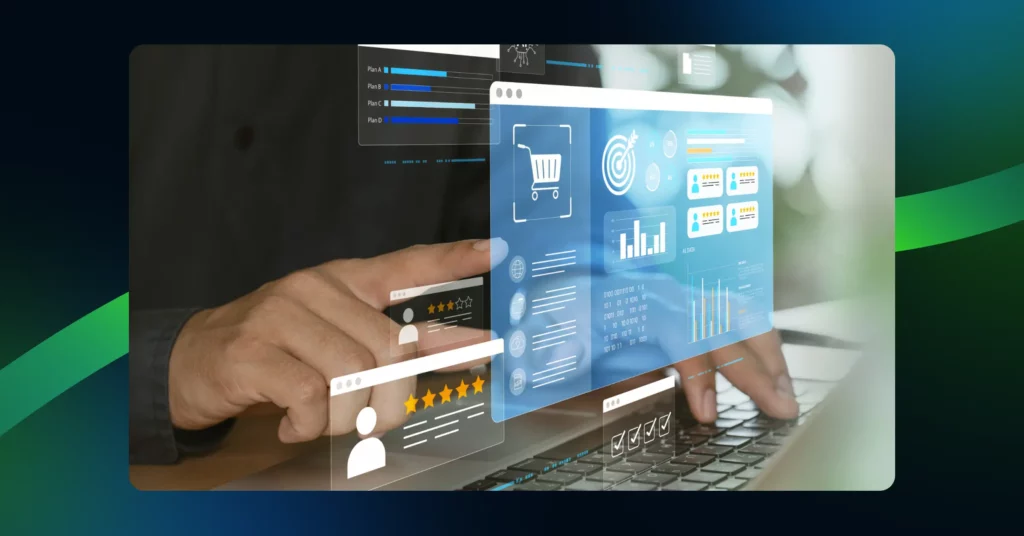In today’s retail world, gut feelings don’t cut it anymore. The retailers winning in e-commerce and brick-and-mortar are making data-backed decisions to optimize their organization–from pricing to product content.
Retail analytics has become a key tool behind smarter strategies, helping businesses stay ahead of changing consumer behavior.
Let’s break down why Analytics is more than an add-on– it’s a must-have for modern retailers.
Keeping Up with Retail
Retail is evolving at breakneck speed. Global e-commerce sales are projected to hit $8.3 trillion in 2025, representing a 55.3% growth since 2021. It’s confirmation that consumers are moving across channels, and expect seamless experiences, personalized recommendations, and real-time product availability–online or in-store.
There are many stories of once-strong retailers that struggled to adapt to new consumer shopping habits and economic realities. One lesson? Retailers who don’t embrace data-driven decision-making risk falling behind.
So, what’s holding retailers back from optimizing their strategies?

The Retail Challenges
Even the most successful retailers can struggle with:
- Unpredictable Consumer Behavior – What worked last year might not work today. Without insights, retailers are reacting instead of anticipating.
- Inventory Issues – Too much stock? You’re losing money. Too little? You’re missing sales. Finding the balance is tough without real data.
- Pricing Wars – Competing for price is a constant battle, and without Analytics, it’s easy to lose margins or scare off customers.
- Marketing Misses – Retailers spend billions on marketing, but without data, they’re shooting in the dark—wasting budget on campaigns that don’t convert.
Without clear visibility into performance, pricing, inventory, and customer behavior, these businesses are operating on guesswork—and that’s a dangerous game in today’s retail landscape.
Retail Analytics: The Game-Changer
Retail analytics isn’t just about collecting data. By analyzing sales trends, customer behavior, pricing, and product performance, retailers can turn that data into action to make smarter, faster, and more profitable decisions.
Here are five examples of how Retail Analytics can drive action in an organization:
1. Enhancing Content Quality and Engagement
High-quality product content is essential for converting shoppers. And retailers need to monitor brand content against their retailer requirements. Syndigo’s Vendor Scorecard provides retailers with comprehensive content health scores, identifying areas for improvement and offering actionable recommendations. This ensures that product information is accurate, engaging, and optimized for better customer experiences and increased sales.
2. Optimizing Product Detail Pages (PDPs)
Understanding how customers interact with product pages is crucial for conversion optimization. Syndigo’s Content Engagement Report offers insights into shopper engagement metrics, including time spent on page and interaction rates. These insights allow retailers to refine PDPs, enhancing the shopping experience and boosting conversion rates.

3. Streamlining Vendor Collaboration
Effective collaboration with vendors ensures that product content meets retailer standards and resonates with customers. With Syndigo’s VendorSCOR report, brands can see their compliance, with clear guidance on content requirements and performance metrics, to enable a collaborative environment focused on continuous improvement.
4. Personalizing Shopper Experiences
Personalization is key to meeting modern consumer expectations. Analytics enables retailers to tailor product recommendations and marketing messages based on individual shopper behavior, leading to increased engagement and loyalty.
5. Informing Strategic Decision-Making
Comprehensive analytics provide retailers with the insights needed to make strategic decisions regarding product assortments, pricing strategies, and marketing campaigns. This data-driven approach minimizes risks and maximizes opportunities for growth.
A Key Piece of Product Experience Management (PXM)
Analytics is a critical element of a comprehensive PXM approach. PXM focuses on delivering consistent and compelling product content across channels, and without analytics, there is no feedback loop to offer insights into how that content performs. With real-time analytics, retailers and their brand partners can optimize the product experience. This integration enables retailers to continuously refine their content strategies, ensuring they meet customer expectations and drive conversions.
Final Thoughts: The Time to Act Is Now
The question isn’t whether retailers need Analytics—rather, the question is, how much are retailers missing without it? With increased competition, data-driven strategies will enable retailers to make the informed decisions needed to enhance content quality, optimize product pages, foster effective vendor collaborations, and better personalize shopper experiences. Integrated analytics capabilities are a key part to robust PXM solutions for retailers, enabling them to achieve sustained growth.
Learn more about how Analytics is a core component of Syndigo’s PXM solution for retailers.










